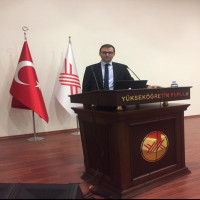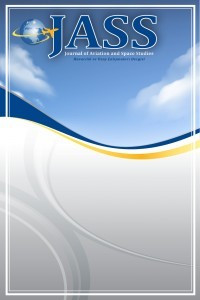Theoretical Article
Research Article
Aim & Scope
Journal of Aviation and Space Studies (Havacılık ve Uzay Çalışmaları Dergisi), is an international, open access, electronic, peer-reviewed, nonprofit, interdisciplinary journal that embraces the highest standards in terms of publication ethics, published by University of Turkish Aeronautical Association, the university of Turkish Aeronautical Association that has an important role and activity in the national and international platforms about Aviation. The main aim of the journal is to increase the exchange of knowledge and to have a contribution in the development of the scientific background in the field of aviation and aerospace by publishing the studies in the regarding interdisciplinary research fields.
In this manner, the aviation and/or aerospace oriented studies in engineering sciences, natural sciences and social sciences are in the scope of the journal. The research areas in the scope of the journal are including but not limited to:
- Aviation and Space History
- Aviation and Space Economics
- Aviation and Space Management
- International Relations in Aviation and Space
- Security Studies in Aviation and Space
- Law in Aviation and Space
- Space Policy
- Software Engineering in Aviation and Space
- Orbital Mechanics and Space Environment
- Attitude Determination and Control
- Spacecrafts and Payloads
- Propulsion Systems and Plasma
- Aviation and Space Engineering (General)
The journal accepts the original research articles and review articles written in Turkish or English. For the guide for authors please see the page Writing Rules.
Author Guidelines
Manuscripts sent to Journal of Aviation and Science Studies should be in accordance with American Psychological Association (APA) 6th edition in terms of its references, footnotes and bibliography.
Click here for the Cover Letter for submission of a manuscript to the Journal.
Manuscript Writing Rules
1. The articles sent to journal should consist minimum 3.000 words and they must not exceed 8000 words.
2. The articles should be typed in Turkish and English, in A4 paper size including the tables and figures with line spacing in 1,5 and 11-point type in “Garamond” font.
3. There should be 3.5 cm margins on each side. The article should be left-aligned with zero binding margins. Paragraphs shall begin with 1.25 cm indent. Footnotes shall be typed in 9-point type in “Garamond” font with 1.0 line spacing. Articles will be returned to the author(s) after the pre-review if they do not comply with the figure rules and content of the journal and they will not be presented to referees for review.
4. The figures, graphics and tables of the submitted articles should comply with the format of the journal. Footnotes, figures, graphics and tables should be placed on the same or the proceeding page of the citations. The notes under the graphics and tables should aim explaining these materials thoroughly without making the reader see the main text. The tables on the text must not be in the form of a software output, and the author(s) must tabulate the findings manually. Tables should be edited to fit the A4 paper size. Graphics as well should not be in the form of a computer software output, and as a drawing or image; they shall be edited to fit the A4 paper size.
5. Journal of Aviation and Science Studies (JASS) is published in Turkish and English. All the submitted articles must have a Turkish tittle, Turkish abstract as well as an English title and English abstract at the top. Abstracts must not exceed 200-250 words. Abstract should contain information about the purpose, methodology, findings and results of the study. Below the abstracts, keywords must be given in both Turkish and English. Author(s) should not use abbreviations in the abstract. In Turkish articles the Turkish abstract and in English articles, the English abstract must come first.
6. All articles must follow the manuscript writing rules stated in “The publication manual of the American Psychological Association (6th edition)”.
Referencing and Citation Styles According to APA 6th edition
APA in the Text
- When referring to an entire work, the (author’s last name, year) is included, e.g. (Öztürk, 2004).
-When referring to part of a work (e.g. a page, paragraph or chapter in a book), the page number is also included, e.g. (Köker, 1998: 42).
- References with the same first author are given as (Zizek, 2009a) and (Zizek, 2009b).
-If a work has two-five authors, all authors are cited the first time, (Kejanlıoğlu, Adaklı ve Çelenk, 2004), and from then on only the last name of the first author is included (Kejanlıoğlu et al., 2004).
- When referring to a work with two authors, both authors’ last names are cited. If a work has more than two authors, all authors are cited the first time, and from then on only the last name of the first author is included.
Gregory, Agar, Lock and Harris (2007) state that getting interested in science is a new way of public relations for private sector. (...) Gregory et al., argue that this way the companies maintain their reputations (2007: 212).
-If there are more than six authors, only the last name of the first author is cited at the first citation as well (Abisel et al., 2005).
-Where your source quotes or refers to another source, the citation might read thus: (Zizek, as cited in Sancar, 2009). Only Sancar will appear in the Reference list.
-If the original date is known, classical books are cited as: (Marx, date of the original work / date of the used book or article)
-When referencing a quotation from an original work triple dot (...) is used to show the removed words. Other short quotations are put in double quotation marks:
Indeed, one researcher commented that “technological innovations have saved or extended the lives of many patients” (Lumby, 2001, p. 44).
-Quotations that are more than 40 words are referenced in quotes with single line spacing, 10-point type and not italicized.
-Abbreviations are given in parenthesis in the text only the first time. For example, “Eventually in 1957, International Monetary Fund (IMF) was referred to pay the international debts. This loan has made the IMF and important figure of the Turkish economy.
-When referring from an anonymous resource, it is appropriate to cite as it is on references with a part of heading included.
For example: In Turkey, the academics in the field of social sciences have had a better chance to find international scholarships to complete their higher education (“Turkey’s Science Academia Report”, 2005:20).
-Usage of numbers: When starting a sentence numerical statements are given with words.
For example:
Twenty of the forty-five thesis (...) was based on text analysis, and the remaining 15 theses were about politics of economy.
-The footnotes in the text are included at the bottom of the page and enumerated.
-If there is only one appendix of the text, it is entitled, italicized and cited in the text as Appendix. If there are more than one, they are lettered and aligned as Appendix A, Appendix B, etc. The appendices coming at the end of the text should be titled. They should be stated with their labels in the main text.
For example:
When the masters and the doctorate thesis about the news made in Turkey are examined (Appendix A and Appendix B) starting form 19902, it is seen that they all focus on representation, ideology and discourse issues.
The heading format valid for in-text heading and subheading sequencing is 5 levelled in APA. If your text is complex and voluminous with many subheadings, use level 1, level 2, and level 3 headings. If your text is complex but it does not need subheadings, use level 1, and level 2 heading formats.
|
Level |
APA Format |
|
1 |
Centered, Boldface, Uppercase and Lowercase Headings |
|
2 |
Left-aligned, Boldface, Uppercase and Lowercase Heading |
|
3 |
Indented, boldface, lowercase heading with a period. |
|
4 |
Indented, boldface, italicized, lowercase heading with a period. |
|
5 |
Indented, italicized, lowercase heading with a period.
|
APA in Reference List
-Reference list should have a single line spacing, 10-point type and a single space between references. All references shall be left-aligned with 1.25 cm indent on the first line. If there is more than one work by the same author, they are ordered by publication date – oldest to newest. The works with the same date are ordered using the letters, e.g. 2000a, 2000b.
-If there are any, the DOI numbers of the journals are included.
For example:
Anderson, A. K. (2005). Affective Influences on the Attentional Dynamics Supporting Awareness. Journal of Experimental Psychology: General, 154, 258–281. doi:10.1037/0096- 3445.134.2.258
-If there aren’t any, the Url number is included. For example, http://cins.ankara.edu.tr/cansun.html
-If the original dates of the classical works are known, it should be given at the end of the reference: (Original work is dated 1846)
-If there are two authors with the same last name, they should be ordered alphabetically according to the first letter of their names, although the former one dates older.
Köker, E. (1998). Politikanın İletişimi İletişimin Politikası, Ankara: Vadi.
Köker, L. (2007). Hukuk Reformları Sürecinde Türkiye’nin İnsan Hakları Sorunu. İnsan Hakları Haberciliği, (comp.) Sevda Alankuş, İstanbul: IPS Vakfı.
-For books and reports, the place of publication and the publishers name is included in order; terms such as Publishers, Co., Inc., Books and Press are not used.
For example:
Ankara: İmge
New York, NY: Mc Graw-Hill
Book with single author
Abisel, N. (2006). Sessiz Sinema. Ankara: Deki.
Corey, G. (1991). Theory and practice of counseling and psychotherapy. Pacific Grove, CA: Brooks/Cole.
Book with Many Authors
Corsini, R. J., & Wedding, D. (1989). Current psychotherapies. Illinois: F.E. Peacock Publishers Inc.
Edited Books
Özbek, M. (Ed.) (2005). Kamusal Alan. İstanbul: Hil.
Chapter in An Edited Book
Foskett, N. (1997). Teaching and learning through fieldwork. In D. Tilbury & M.Williams (Eds.), Teaching and learning geography (pp. 189-201). London:
Routledge.
Kejanlıoğlu, B. (2005). Medya Çalışmalarında Kamusal Alan Kavramı. Meral Özbek (Ed.), Kamusal Alan İçinde (s. 689-713). İstanbul: Hil.
Book with More Than One Edition
Strunk, W. Jr. & White, E. B. (2000). The Elements of Style (4th ed.). New York: Longman.
Smith, P. (2012). Cut to the chase: Online video editing and the Wadsworth constant (3rd ed.). Washington, DC: E & K Publishing.
Electronic Sources
The retrieved URL is included.
http://www.bianet.org/bianet/toplum/119375-avatar-in-sozde-solculugu-uzerine
Electronic Journals
DOI (digital object identifier) number shall be included if there is any.
Von Ledebur, S. C. (2007). Optimizing knowledge transfer by new employees in companies. Knowledge Management Research and Practice. Advance online publication. doi: 1 0.1 057/palgrave.kmrp.8500141
Multivolume Books
Pflanze, O. (1963-1990). Bismarc and the Development of Germany (Vol. 1-3). Princeton, NJ: Princeton University Press. In-text: (Pflanze, 1963-1990)
Using Single Volume in Multivolume Books
Pflanze, O. (1990). The Period of Fortification, 1880-1898: Vol. 3. Bismarck and the Development of Germany. Princeton, NJ: Princeton University Press.
A Chapter Translated from A Book
Weber, M. (1958). The Protestan Ethic and The Spirit of Capitalism. T. Parsons (Tra.). New York: Charles Scribner‟s Son. (1st ed. 1904-1905).
In-text: (Weber, 1904-1905/1958)
Articles with Single Author from Journals
Aktay, Y. (1999). Aklın Sosyolojik Soykütüğü: Soy Akıldan Tarihsel ve Toplumsal Akla Doğru. Toplum ve Bilim, 82, 114-140
Articles with Many Authors from Journals
Binark, F. M. & Çelikcan, P. (1998). Mahremin Müzakereye Çağrılması ve Yıldo Örneği. Kültür ve İletişim, 1 (2), 197-214.
Articles Published in Electronic Journals
Conway, P. (2003). Truth and reconciliation: The road not taken in Nambia. Online Journal of Peace and Conflict Resolution, 5 (1). (DOI number is inluded. If not, URL is included. http://www.trinstitute.org/ojpcr/5_1conway.htm)
Unpublished Dissertations, Posters, Papers
Sarı, E. (2008). Kültür Kimlik ve Politika: Mardin’de Kültürlerarasılık. (Unpublished doctoral dissertation). Ankara Üniversitesi/Sosyal Bilimler Enstitüsü, Ankara.
Encyclopedias
Balkans: History. (1987). In Encyclopaedia Britannica (15. Ed. Vol. 14, p. 570-588). Chicago: Encyclopaedia Britannica.
Carruthers, E.P. (2002). Nursing. In Funk & Wagnalls new world encyclopedia. Retrieved from Funk & Wagnalls New World Encyclopedia database.
In-text: (Balkans: History, 1987)
Dictionaries
Gerrymander. (2003). Merriam-Webster’s collegiate dictionary (11th Ed.). Springfield, MA: Merriam-Webster‟s.
In-text: (Gerrymander, 2003)
Samples for Tables and Figures
In-text tables shall be formed similar to the sample below according to its content. Title of the table will be placed on the top, left- aligned and bold.
Table 1: The First Letter of Each Word on the Table Heading Should Be Capitalised
|
|
ffff
|
bbbbb
|
nnnn
|
||
|
Zzzzz
|
1. |
47 |
30.3 |
47 |
30.3 |
|
2. |
60 |
38.7 |
60 |
38.7 |
|
|
3. |
48 |
31.0 |
48 |
31.0 |
|
|
Cnnn
|
K |
117 |
75.5 |
117 |
75.5 |
|
E |
38 |
24.5 |
38 |
24.5 |
|
|
|
|
|
|
|
|
|
Total
|
|
155 |
100 |
155 |
100 |
|
|
|
|
|
|
|
Resource: Surname, Year: Page number.
Figure 1.1. Davis’in Bilişsel-Davranışsal Patolojik İnternet Kullanım Modeli
Resource: Surname, Year: Page number.
Note: The figures and pictures should be at least dpi.
Ethical Principles and Publication Policy
Price Policy
This electronic and nonprofit journal is an open access journal, and no fee is requested from the authors or readers.
Indexes
Journal Boards
Owner
Editor

Editorial Advisory Board





Section Editors














Layout Editors














